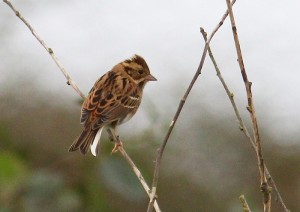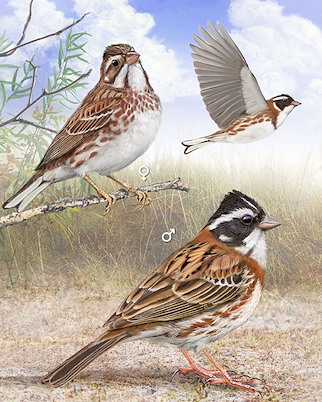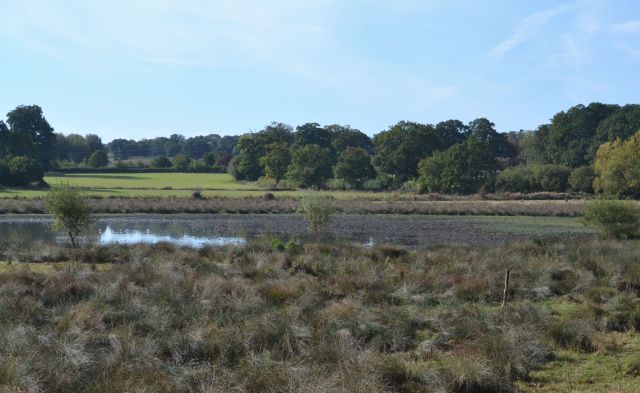I wasn’t expecting too much from a week long change of season break in Crete. The plan was more to experience another large Mediterranean island I had wanted to visit for some time, rather than to pursue an intensive wildlife agenda. Where butterflies were concerned there are two endemics, Cretan Argus and Cretan Grayling, the second of which ought still to be flying. Better pictures for my collection of Lang’s Short-tailed Blue and Cardinal would be very welcome. And then there are Plain Tiger.
The last-named is perhaps one of the world’s most widely distributed butterflies. Various sub-species occur throughout Africa and much of tropical Asia, as well as the southern Pacific region and Australia. In Europe it is found in the Canary Islands and sporadically around some coastal Mediterranean regions, including Crete from May to October. I had come across the species just once before in Morocco (Nov 2015) but did not get a picture.
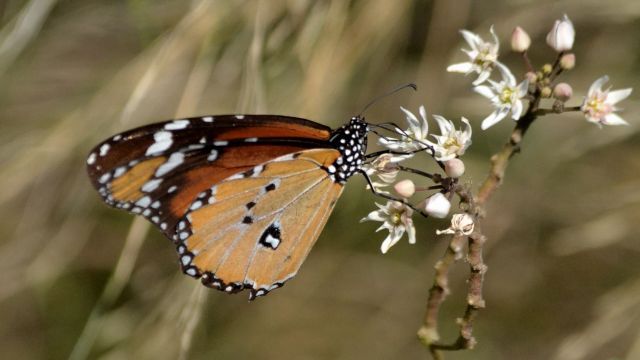
Plain Tiger at Georgioúpoli … what a blurry beauty!
It took until the close of my trip’s final day to make this self-find. Visiting the seaside town of Georgioúpoli on the north coast I found it to be a nicely laid back and picturesque place, at least at this time of year, with an ambience of pavement tavernas and boaty promenades. I had read that the Almiros estuary along the western edge of the town was a good wildlife area, and so after buying presents in the main square headed out there.
As I strolled along taking landscape pictures (above) a first Plain Tiger flew over my head and kept going. Then I found a small colony and the serious beauty of this striking, continuously brooded insect did not disappoint. It is a member of the Danaidae order of large tropical butterflies which also includes another wide ranging migrant, Milkweed or Monarch and the colouring is similar. Those are the only two members of that family that occur in Europe.
In my on-site excitement I failed to notice how worn some of the butterflies were. The image below was earmarked for inclusion in my premium gallery (see here) until after viewing it on my desktop computer back at home I noticed the condition of the lower individual. But that does not stop Plain Tiger being my top insect sighting of the trip.
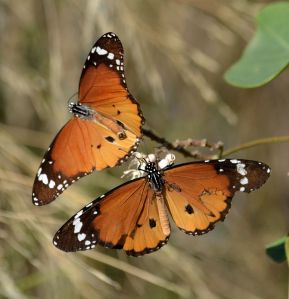
The west is the not so commercialised and more natural end of Crete, with far less intensive development for mass market tourism. It is also where the wildlife tour operators go in both spring and autumn, but at this time of year their itineraries are botanical in bias. Crete is renowned for a mass flowering of bulbous plants after the first autumn rains, and is also a top grade hiking destination, both of which attract visitors more interested in the natural world than a beach holiday.
For my base I chose the excellent Galini Sea View hotel in Stalos, along the coastal tourist strip to the west of the regional capital Chania. What I most seek from a room is a good view, but I didn’t anticipate getting the one on the web page (below, left). I chose this hotel because it is on a hill and from Google Earth I could see there was undeveloped land nearby in which to search for butterflies and other insects. Oh, and it also offered an affordable all inclusive package.
Hence on day one (22nd) I set out on foot simply to explore the surrounding area (above, right), as I like to do at the start of a trip. With my particular motivation any piece of waste ground wherever I might be is potentially productive and interesting, and my choice of location this time proved to be a wise one. As that sunny morning warmed up I recorded 15 mostly multi-brooded and hence common Mediterranean species, but these included two that were either new to me or previously un-pictured.
This whole locality on the hillsides above Stalos was teeming with butterflies. Painted Lady and Clouded Yellow (pictured above) were everywhere, and I cannot recall having ever found so many Swallowtail in one place. The last-named offered some pleasingly creative picture opportunities (below). Lantana, the red flower is sold as a hanging basket plant at home. When I come across it abroad I always recall a South African in an English garden centre saying it is an invasive weed where he comes from. There is certainly plenty of it in this part of Crete, and always worth checking for butterflies. Click on any image to enlarge.
I was especially pleased to find a Southern Comma here. I had observed this butterfly for the first time in Delphi, southern Greece last June (see here), but only secured underwing pictures. The female in these new images (below) is certainly very different from the Commas we are familiar with in Great Britain. This species occurs across the northern Mediterranean region, from the south of France, through Italy, the Balkans, mainland Greece and into Turkey.
Geranium Bronze (below) is an introduced species I had read of many times but not come across in the field until now. This attractive little South African number is attributed with having arrived in the Mediterranean as eggs or larvae via the horticultural trade in Pelargonium plants. First reported in 1990 in Mallorca, it has since expanded its range quite vigorously and is regarded as a pest species, at least by people who cultivate ornamental Pelargoniums.
I only located one of the above, but Mediterranean Skipper (below) were quite abundant. This drab brown Skipper is fairly localised, ranging sporadically across Mediterranean coastal regions from May through to late autumn. I had noticed them before in Cyprus (Nov 2011) but not obtained any pictures worth keeping. That situation was put right on this trip.
I particularly wished to get better pictures of Lang’s Short-tailed Blue here in Crete. That diminutive and hyperactive little butterfly is very difficult to capture well, being constantly on the move and disinclined to perch openly. But here I achieved that aim when the sun went in temporarily and the individual in the image (below, left) kept stock still for quite some time. In these crops this common and widespread southern European blue may look larger than life size, actually being not much bigger than a Small Blue.
Other common species on the wing here were Wall Brown, Speckled Wood, Common Blue, Brown Argus, Small Copper, Large and Small White, and frequent Red Admiral. In the absence of an agenda to track down new must-finds, I found myself taking time, untypically to pay attention to some of these and perhaps picture them against new and different plants.
Initially I hoped the paler toned Argus (above, right) might be a Cretan. But on reading things up that endemic is confined to certain mountain locations and flies in high summer. So I think this particular butterfly is most likely a rather faded female Brown Argus.
Perhaps a case in point where stopping to bother with very commonplace butterflies is concerned were the myriad Small White here. Normally they are difficult to do justice to in bright sunshine. But on this occasion a pleasing light meant I added some good images to my collection. So here (below) is a mini-celebration of the humble Small White, proof perhaps that there is no such thing as a mundane butterfly.
By early afternoon conditions had become overcast. So I walked the seafront, quickly realising that most of the area had closed down for the winter already. In the evening I found out my hotel was following suit at the end of my stay. It was a slightly surreal experience being in such a large establishment with so few guests, but also reminiscent of the memorable three weeks spent in Tavira, southern Portugal in January 2014. The weather stayed unsuited to insects through to Friday (25th) which dawned clear and bright. Then, having hired a car in the interim I headed to Levka Ori, the White Mountains of Crete.
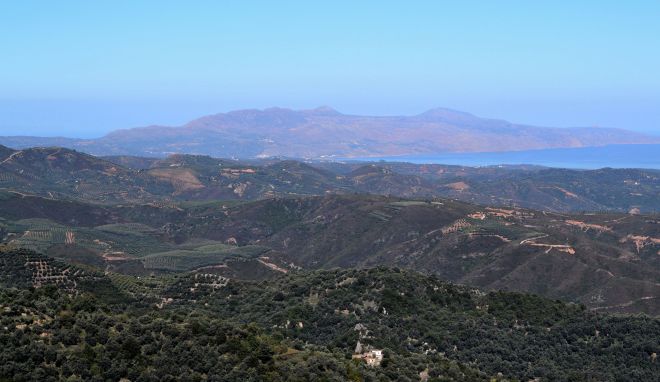
Northward vista on the mountain road above Fournés
As I wound onward and upward in my vehicle the same yellow-flowered shrub that dominated the hillsides above Stalos now lined the roadside verges. Once again I found time to devote to commonplace, late-brooded species if only because nothing else was available. Wall Brown is another butterfly not normally given to keeping still for the camera, but here in the cool light of morning they were far more docile than usual. Sure enough as the day warmed up, and after these images (below) were captured they became more flighty and difficult again.
Above the cultivation altitude the landscape changed dramatically, becoming now stony and scrubby. I stopped at such a roadside spot that looked good for Cretan Grayling and a short search duly produced one. The differences from regular Grayling (Hipparchia semele) are only slight (the proportions of the male genitalia aside!), but this endemic (Hipparchia cretica) is the sole Grayling to occur in Crete so I could be confident of the ID. The pictured individual (below) was the only one of the prime trip target I encountered all week.
The as ever cryptically patterned, endemic Cretan Grayling (above and below)
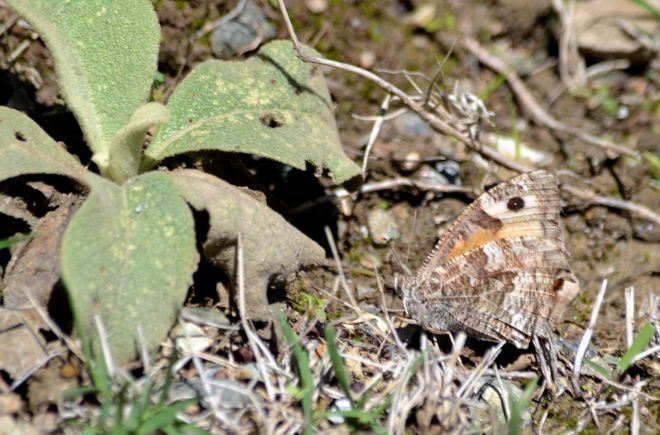 In this rocky habitat I also began to encounter lizards, without which no Mediterranean trip report would be complete. The endemic Cretan Wall Lizard was separated as a species in 2008. This is a medium-sized lacertid reaching 20cm in length, though like all of that extensive genus there can be much variation in size and colouration. It is the only lizard to occur in Crete, being distributed throughout the west at altitudes up to 2000m.
In this rocky habitat I also began to encounter lizards, without which no Mediterranean trip report would be complete. The endemic Cretan Wall Lizard was separated as a species in 2008. This is a medium-sized lacertid reaching 20cm in length, though like all of that extensive genus there can be much variation in size and colouration. It is the only lizard to occur in Crete, being distributed throughout the west at altitudes up to 2000m.
Following these sightings I continued up to the Omalos plateau that is said to be one of the more likely places in Crete where Lammergeier might be observed. I wasn’t lucky and there were very few butterflies up there either, the land being heavily grazed. In the afternoon I drove on to the idyllic village of Soúgia on the south coast, stopping where I thought there could be good butterfly habitat, but things were much more disappointing in that respect than the spectacular scenery (below). It is approximately 50 miles distance from the north to south coasts of western Crete.
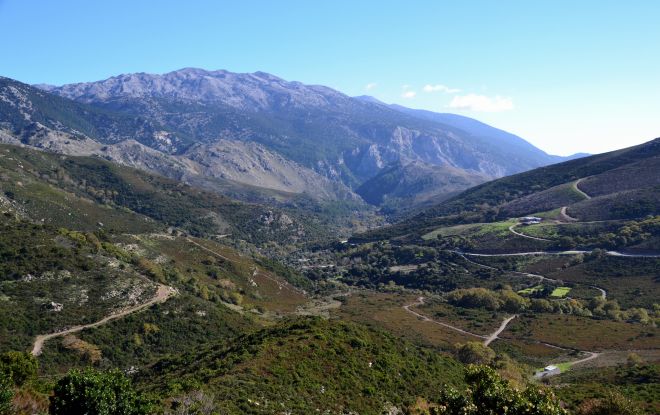
Southward vista on the descent from Omalos to Soúgia
On the morning of my final day in Crete (27th) I paid a second visit to Lake Ayia, an ageing and partially overgrown man-made reservoir some 5km north of my base. Earlier in the week I had noted good dragonfly habitat here, and with sunshine now prevailing I came to see what might be about. There were a lot of Migrant Hawker, with a few Lesser Emperor mixed in that as ever did not settle, and some Red-veined Darter.
The only dragons to co-operate for the camera were some Violet Dropwing (above) that posed close to the barrage wall and hence not so directly into sunlight as the larger species. I had thereby observed this attractive, northward expanding African species in Portugal, Morocco, Sardinia and now Crete. A Common Bluetail at Lake Ayia (above, top right) was the only damselfly of the week.
Along the barrage-top path I came across a flowering shrub that was attracting Lang’s Short-tailed Blue and larger Long-tailed Blue (pictured below) butterflies, both of which are common and widespread in southern Europe. The same plant was being pollinated by several Carpenter Bee. I seem to find these big, buzzing, blue-toned beauties wherever I go in the Mediterranean and will admit to having a bit of a soft spot for them. They get their name from a habit of boring into wooden structures and hence might not be so well thought of locally.
In the afternoon I moved on to Lake Kournas (below) some 30 miles to the east and just north of Georgioúpoli where this narrative began. Kournas is the only natural fresh water lake in the whole of Crete and also a popular playground with local people and holiday makers alike. So I drove past all the tavernas and paddle boat concessions to park at what looked like the quieter end of the site. This place must heave in high season.
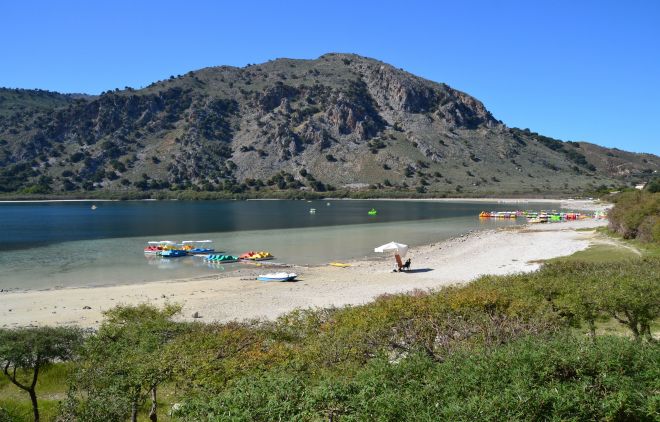
Lake Kournas
First I walked a track behind the lakeside tree-line, where more common butterflies (pictured above) were active and a female Red-veined Darter sat up nicely. Then I spent some time along the stony edge to the beach in the top landscape, away from all the boats where good and roughly equal numbers of Red-veined Darter and Violet Dropwing were busying themselves. Here I got into my element, just taking pictures with no special agenda. The over-mature male in the sequence below, a different colour form was actually seen on the hillside above Stalos earlier in the week.
Lastly, there must be a trillion trillions of Grasshoppers in Crete. Wherever I trod in the wild these attractive and fascinating insects would fly in all directions from my footfall, often displaying a flash of one or another bright colour as they went. I am possibly becoming a little more adept at noticing where they land now than the predators that strategy is designed to confuse, and as is my wont on a Mediterranean trip found time to take a selection of pictures.
Once again I couldn’t help but notice how the different individuals in the sequence above invariably seem to match the backdrop. And so I wondered once more if these creatures are changelings that can actually alter their tones to blend in with the habitat wherever they might be. I remain open to advice from any reader who might be able to offer it.
The butterfly list for this trip (with lifers in Bold) was: Swallowtail, Large White, Small White, Clouded Yellow, Cleopatra, Small Copper, Long-tailed Blue, Geranium Bronze, Lang’s Short-tailed Blue, Brown Argus, Common Blue, Plain Tiger, Red Admiral, Painted Lady, Southern Comma, Cretan Grayling, Meadow Brown, Speckled Wood (P a Aegeria), Wall Brown, Mediterranean Skipper – 20
Red-throated Pipit and Bearded Reedling near Chania – 25th Oct
Birds were not a high priority on this trip since there was little likelihood of seeing anything new unless I was fortunate enough to encounter a Lammergeier in the mountains. By all accounts that mythical raptor is just as scarce in Crete as in Corsica and Sardinia and it eluded me again as in those other islands. So my wait to experience one must go on.
The one full day I devoted to birding was Thursday (25th), starting at Lake Ayia that my pre-trip researches indicated is Crete’s best location. If that is so then I can only say it reflects why Crete is not a prime destination for dedicated birders. There were some highlights however that morning, as first a pair of Booted Eagle came in and out; then my third Lesser Spotted Eagle drifted over or so I was informed afterwards by another birder. That knowledgeable German gentleman who had been visiting Crete for 30 years confirmed that Lake Ayia in his view is somewhat past it’s prime.
He also told me of a site on the western edge of Chania (pictured above) where there were currently small flocks of Red-throated Pipit and Bearded Reedling, the latter being a very scarce bird in Crete. So that was where I went on to in the afternoon. One rather refreshing aspect of visiting Crete was the ease of parking for free and so it was again here. I crossed a bridge onto some undeveloped land across a small river and fairly quickly came upon several Pipits feeding busily on the ground.
I had self-found Red-throated Pipit once before in Cyprus (Nov 2011), an unmistakeable adult complete with red throat, and so needed to re-assure myself I had indeed located the birds I had been directed to on this second occasion. But having checked the grainy digiscoped images (below) against RBA’s gallery of winter plumaged birds seen in Great Britain, I am confident of the ID though still open to correction.
RTP is a tundra breeder that winters in Africa and locally in the Middle East. The Helm guide to confusion species describes this bird as colder and less buff than Meadow Pipit and much more heavily streaked. The lateral throat-stripe ends in a thick blotch on the neck-sides, joining heavy broad breast striping. The upperparts are strongly striped and the wings also strongly marked. I do hope I have got this ID right.
After a while on-site, and since there were no other birders present, I started moving around and getting closer to the Pipits to try for better pictures in the poor light, but without success. There were also Crested and Short-toed Lark here, and White and Yellow Wagtail. Then the Bearded Reedling flock flew over my head, pinging as they went, to land in vegetation by the river exactly where the German birder had advised me to look. My images are no better than those of the Pipits but still show what I saw.
This dual sighting was the birding highlight of the week. In the White Mountains the following day I twice saw Griffon Vulture overhead, but in general I majored on insects for this trip since my various southern European posts in this journal receive a good level of consultation from web searchers, and I am not really a proper birder after all. So I have now added another large Mediterranean island to my life’s experience. But six days was enough merely to scratch the surface in this so wild and scenic principality of Greece, and hence I may return.













































































